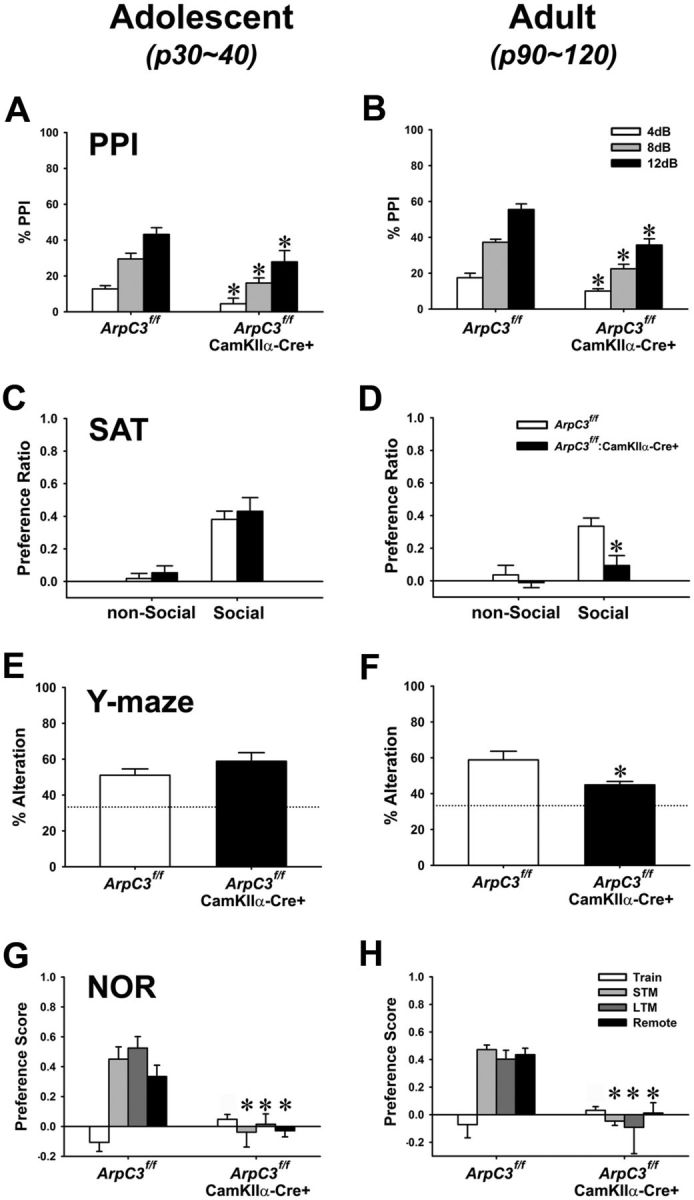Figure 7.

Analyses of PPI, sociability, working memory, and episodic memory in young and adult ArpC3f/f:CaMKIIα-Cre mice. A, B, Percentage PPI of acoustic startle responses at 4, 8, and 12 dB prepulses (over a 64 dB white noise background) (adolescent n = 15 control, n = 10 cKO; adult n = 9 control, n = 9 cKO). ANOVA with repeated measure revealed significant main effects of test-phase (4–12 dB) (F(2,42) = 34.17, p < 0.001 for adolescent mice; F(2,32) = 81.33, p < 0.001 for adults) and genotype (F(1,21) = 11.95, p < 0.01 for adolescent mice; F(1,16) = 31.67, p < 0.001 for adults), but no test-phase × genotype interactions. Bonferroni-corrected pairwise comparisons noted that the PPI of mutants against all three prepulse levels (4, 8, and 12 dB) were decreased in both adolescent and adult mice compared with their littermate controls (*p < 0.05). C, D, Preference ratio for nonsocial or social stimuli in the social affiliation test (SAT) (adolescent n = 13 control, n = 13 cKO; adult n = 13 control, n = 12 cKO). C, For adolescent mice, ANOVA with repeated measure revealed a significant main effects of test-phase (F(1,23) = 48.71, p < 0.001). However, there was no genotype effect (F(1,23) = 0.632, p = 0.43), nor test-phase × genotype interaction. D, For adult mice, ANOVA with repeated measure noted significant main effects of test-phase (F(1,20) = 6.54, p < 0.05) and genotype effect (F(1,20) = 14.38, p < 0.001), whereas no significant test-phase × genotype interaction was detected. Bonferroni comparisons showed that the social interactions of adult mutants with the stimulus mouse was decreased compared with littermate controls (*p < 0.001). E, F, Y-maze test of working memory showing the average of percentage correct alternations. Dotted line indicates percentage alternations expected by chance (33%) (adolescent n = 14 control, n = 13 cKO; adult n = 9 control, n = 9 cKO). Independent t test revealed that the correct alteration rate of adolescent mutant mice was not different from littermate controls (E) (t(1,25) = 1.39, p = 0.177), whereas adult mutants showed a significantly decreased correct alteration rate compared with their controls (F) (t(1,16) = 2.52, p < 0.05). G, H, Novel object recognition (NOR) test of short-term (STM), long-term (LTM), and remote memory. The preference score for the novel object is shown (adolescent n = 14 control, n = 13 cKO; adult n = 9 control, n = 9 cKO). ANOVA with repeated measure revealed significant main effects of test-phase (F(3,75) = 5.59, p < 0.01 for adolescent mice; F(3,42) = 3.53, p < 0.05 for adults), genotype (F(1,25) = 64.91, p < 0.001 for adolescent mice; F(1,14) = 23.59, p < 0.01 for adults), and significant test-phase × genotype interaction effect (F(3,75) = 19.15, p < 0.001 for adolescent mice; F(3,42) = 7.14, p < 0.001 for adults). Bonferroni-corrected pairwise comparisons noted that adolescent cKO mice have deficits in all three types of memory capability (short-, long-term, and remote memory) compared with those of littermate controls (*p < 0.05).
